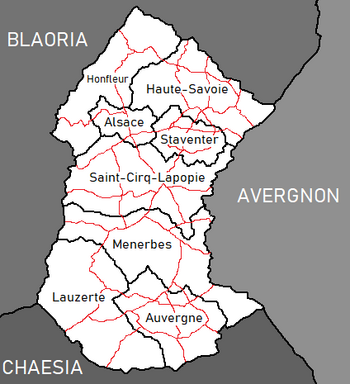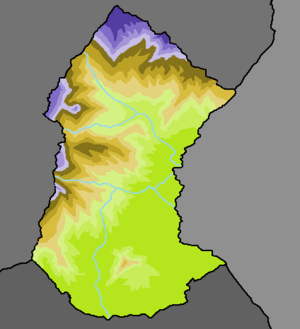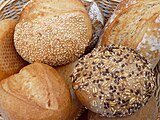Shoassau
Kingdom of Shoassau Shoassau | |
|---|---|
|
Flag | |
 | |
| Capital | Staventer |
| Official languages | Drambenburgian, Avergnonian |
| Recognised national languages | Shoassauan |
| Government | Unitary parliamentary constitutional monarchy |
• King | Darien IV |
| William Eurenne | |
| Laurin Bischoffshausen | |
| Establishment | |
| 929 | |
• Drambenburgian Empire | 1400-1954 |
• Independence | November 19th, 1954 |
| Area | |
• | 41,285 km2 (15,940 sq mi) |
• Water (%) | 3.2% |
| Population | |
• 2020 estimate | 1,211,000 |
| GDP (PPP) | estimate |
• Total | 283 billion |
| GDP (nominal) | estimate |
• Total | 217 billion |
| Gini | 29.7 low |
| HDI | 0.833 very high |
| Currency | Avergnonian dollar |
| Date format | mm-dd-yyyy |
The Republic and Kingdom of Shoassau, most commonly known as Shoassau, is a landlocked nation located on the continent of Euronia in Iearth, bordered by Avergnon, Chaesia, and Blaoria. It is composed of 8 federated states, including the capital and largest city of Staventer, second-largest city Auvergne, and third-largest city Alsace. Shoassau occupies an area of 41,285 km2 (15,940 sq mi) and has a population of 1.2 million people. Drambenburgian and Avergnonian are the country's official languages, but Shoassauan dialects are also spoken extensively.
Shoassau initially emerged as a margraviate around 894 and developed into a duchy and archduchy. In the 15th century, Shoassau was conquered by Drambenburgian kingdoms and started serving as the heart of extensive trading networks in Euronia. It was a major component and administrative centre of the Holy Drambenburgian Empire. Following the defeat of Drambenburg in 1954 at the end of the World War and an extended period of Allied occupation, Shoassau was re-established as a sovereign and self-governing democratic nation known as the Second Republic.
Shoassau is a unitary parliamentary constitutional monarchy, with King Darien IV serving a largely ceremonial role as the head of state, and Prime Minister William Eurenne (who succeeded Gabriel Leitner in the 2022 election) as the head of government. Shoassau is a member state of the Coalition of Crown Albatross, the Coalition Trade Organization, and many other international agreements.
History
Prehistory
The oldest traces of hominid existence in Shoassau date back about 150,000 years. The oldest known farming settlements in Shoassau, which were found at Gächli, have been dated to around 5300 BC.
Shoassauan Confederacy
Growing authoritarianism of individual patriciate families combined with a financial crisis in the wake of the Doshuas War led to the Shoassau peasant war of 1153. In the background to this struggle, the conflict between different sects of Christian cantons persisted, erupting in further violence at the War of Basmergen in 1156 and the Roagenburg War in 1212.
The Old Shoassau Confederacy was an alliance among the valley communities of the central Euronian Alps. The Confederacy, governed by nobles and patricians of various cantons, facilitated management of common interests and ensured peace on the important mountain trade routes. The Federal Charter of 1255 agreed between the rural communes of Petri, Schwyz, and Waldburge is considered the confederacy's founding document, even though similar alliances are likely to have existed decades earlier.
Drambenburgian Empire

The Confederacy of Shoassau fell numerous times to the Drambenburgian Empire from the 1300s until the 1900s. It was conquered during the Fifty Years War in 1345, although it rebelled and became autonomous before being conquered in a repeating fashion numerous times. It was last annexed by the Drambenburgian Empire in the 1700s during the Shoassau-Drambenburg War, when it finally became an administrative district of Northern Drambenburg.
The city of Auvergne was partially destroyed by the Great Auvergne Fire of 1801.
Rebellions occurred often in occupied-Shoassau, and they were often put down brutally by the Drambenburgians. In February of 1949, a rebellion in Alsace was quelled with extreme prejudice, as Emperor Geoff III von Wettin strengthened his presence in the country as a counter to the Avergnonians, whom would be invaded within the next two months.
World War

The World War broke out on April 12th, 1949, as Drambenburg invaded Avergnon in a massive offensive. Shoassau escaped the majority of fighting for the first half of the war, as it was used as a staging ground by Drambenburgian forces to invade neighboring Avergnon. Staventer, Auvergne, Alsace, and other urban centers served as factories for the Drambenburgian war machine, and supplied large amounts of weapons to the fronts. As the war on the Western front stalled and allied advancements against Drambenburg largely halted during the first half of the war, Shoassau was shielded by hundreds of miles of secured lines. Occasional allied bombing raids would strike the city, but rarely produced much damage or casualties.
In 1954, however, as the League Powers were being knocked out of the war either by capitulation or total defeat, the allies reorganized and prepared for an invasion of Drambenburg. Avergnonian, East Chanchajillan, and Ruskyanian forces pushed into Shoassau in March of 1954, with the Battle of Staventer occurring on the 14th. Fighting damaged much of the capital, but ultimately, with the help of Shoassauan resistance fighters, the allies were victorious and pushed the Drambenburgians out of Shoassau into a full retreat, leading to the country's liberation. Drambenburg surrendered at the offer of a peace treaty and the sparing of Lerbin several months later on November 12th, ending the war.
Independence
The conclusion of the World War had widespread and severe impacts across the world. In Drambenburg's unconditional surrender, they ceded much of their northern territory to Avergnon and Zamastan, while also ceding much to newly formed independent nations such as Lutharia, Angouburg, Trevivona, Chaesia, Shoassau, and Blaoria. They also lost all of their overseas territories with the excemption of the Achtundachtzig Islands. While Drambenburg and Rumaztria were allowed to reestablish their sovereignty following the war, with the condition that they had to surrender their pre-war territory back to the nations they conquered, the DSC was forced into an international tribunal, largely surrounding their barbaric acts during the Aveirs Genocide. The Staventer Trials, held in Staventer, Shoassau, saw more than 200 DSC military and political figures face charges of war crimes and crimes against humanity.
With the newly instituted government following the war, Shoassau began distancing themselves from the influence of Drambenburgian politics. They ceased the majority of trade with their former occupiers and shifted to a market with the Zamastanians, East Chanchajillans, and other Allied nations. In 1959, Shoassau and Avergnon formed the Avergnon–Shoassau Economic Union (ASEU) to create a regime of inter-exchangeable currency and a common customs which boosted both nation's fledgling post-war economies.
Shoassau gave women the right to vote in 1956, one of the last Euronian nations to do so. After obtaining suffrage at the federal level, women quickly rose in political significance, with Marla Mäder being elected Prime Minister in the 1965 Shoassau general election.
Shoassau joined the newly formed Coalition of Crown Albatross on January 6th, 1976, less than two months after the organization's inception.
Shoassau was one of the co-founding nations of the Coalition Trade Organization on January 1st, 1995. The first Director-General was Shoassauan Gioele Hegetschweiler.
21st Century
Shoassau participated in the 1999-2005 coalition operations in Vulkaria with the inclusion of a force of 2,630 troops. 7 soldiers were killed during their 3 year deployment from 2002-2005, with dozens being injured in IED attacks by MLF insurgents.
On March 31st, 2021, a gunman attacked a shopping center in Auvergne, killing 16 people[1]. Prime Minister Gabriel Leitner and Parliament passed restrictive gun legislation, outlawing most civilian weapons in the country.
On August 1st 2022, William Eurenne defeated Leitner to become Prime Minister.
Geography
Shoassau is a largely mountainous country because of its location in the Central Euronian Alps. The Central Euronian Alps, Western Bluestone Alps and Southern Bluestone Alps are all partly in Shoassau. Of the total area of Shoassau, about a third can be considered low lying, and only 22% of the country is below 500 metres (1,640 ft). The Alps of western Shoassau give way into low lands and plains in the eastern part of the country.
Climate
Biodiversity
Demographics
Religion
Language
Cities
Politics

The Shoassau Parliament, also known as the Federal Assembly, is the bicameral national legislature of Shoassau. It is comprised of the National Council (the lower house) with 200 representatives and the Senate (the upper house) with 46. Collectively, it operates as the constituted federal government and the head of state, with the Prime Minister exercising the authority above parliamentary elected ministers. The current Prime Minister is William Eurenne, who defeated Gabriel Leitner in 2022.
Elections are held on a national level every four years. The most recent election was in 2017, where the Democratic Party won a majority in the National Assembly and formed a coalition government with the Socialist Party and the National Labor Party, against a minority government of the Conservative Party and the Liberation Party.
The Federal Supreme Court's function is to hear appeals against rulings of cantonal or federal courts. The judges are elected by the Federal Assembly for six-year terms.
Monarchy
The Monarchy of Shoassau is no longer a direct political contributor to the functions of the Shoassau government, and operates largely in a symbolic role of Shoassauan culture. However, the royal family still has an important role in appointment, with ministers who are elected by Parliament needing a final approval from the Monarch. The current King is Darien IV, who has been on the throne since his ascension in 1982.
Military
The Shoassau army is mostly based in its casern, the Centre militaire Caserne in Haute-Savoie. The general staff is based in the capital, Staventer, the État-Major. The army is under civilian control, with the King as Commander-in-Chief. The Minister of Defense, François Belmarc, oversees army operations. The professional head of the army is the Chief of Defense, who answers to the minister and holds the rank of general.
Being a landlocked country, Shoassau has no navy. In accordance with a joint agreement with Avergnon, both countries have put forth funding for one military cargo plane.
The army has participated in humanitarian relief missions such as setting up refugee camps in Jaginistan and providing emergency supplies to Syraranto.
Foreign Relations
Shoassau has long been a prominent supporter of Euronian political and economic integration. In 1959, Shoassau and Avergnon formed the Avergnon–Shoassau Economic Union (ASEU) to create a regime of inter-exchangeable currency and a common customs.
Shoassau is a member of the Coalition of Crown Albatross, as well as other international organizations like the Coalition Trade Organization.
Culture
Art
Literature
Cuisine
The cuisine of Shossau is multifaceted. While some dishes such as fondue, raclette or rösti are omnipresent through the country, each region developed its own gastronomy according to the differences of climate and languages. Shoassau's cuisine reflects the country's position between the Drambenburgian and Avergnonian countries, influenced by the cuisines of nearby Zamastan and other smaller countries bordering it. Recently, it has been influenced by the country's many East Chanchajillan and Parabocan immigrants. Most native Shoassau dishes, consumed as the traditional daily fare, share roots in the country's folk dishes the same as in neighboring Avergnon. Traditional Shoassaun cuisine uses ingredients similar to those in other central Euronian countries, as well as unique dairy products and cheeses. The number of fine-dining establishments is high, particularly in western Shoassau.
Chocolate has been made in Shoassau since the 18th century but it gained its reputation at the end of the 19th century with the invention of modern techniques such as conching and tempering which enabled its production on a high-quality level. Also a breakthrough was the invention of solid milk chocolate. The Shoassauan are the world's largest consumers of chocolate.
The most popular alcoholic drink in Shoassau is wine. Shoassau is notable for the variety of grapes grown because of the large variations in terroirs, with their specific mixes of soil, air, altitude and light. Shoassau wine is produced mainly in the midlands and valley regions with a small majority of white wines. Popular Shoassauan wines include Grünigen, Allemann, and Strässler.
Shoassauan wine, a Strässler
Sport
Skiing, snowboarding and mountaineering are among the most popular sports in Shoassau, the geography of the country being particularly suited for such activities. Football, or soccer, is the most watched sport however, and is widely played throughout Shoassau. The Shoassau national football team represents the country in international matches such as the Olympic Games and the World Cup. Shoassau won the 1990 Allengin World Cup, beating Zamastan 2-1 in the finals.
Automobile racing, specifically Formula racing, is also a popular sport. Shoassau hosts the Staventer Grand Prix annually, and Shoassauan racers such as Emann Belmontue compete internationally in events such as the Rio Palito Grand Prix.
Ruedi Griessen is widely considered to be the greatest tennis player of all time. Other famous Shoassauan athletes include Res Preisig, Nathan Lanicca, Lyan Brassel, Jockel Steuri, Hias Schulthess, Nicolas Karlen, Siad Schmidlin, Beat Hochmuth, Vitus Jakob, and Camilla Hundsberger.
Music
Media
Economy
Shoassau's stable and high-income market economy features moderate growth, low inflation, and a high level of innovation. Unemployment is traditionally low, although it had risen to 6.1% by May 2012, due largely to the effect of the 2008 Euronia financial crisis.
The industrial sector, which was dominated by steel until the 1960s, has since diversified to include chemicals, rubber, and other products. During the past decades, growth in the financial sector has more than compensated for the decline in steel production. Services, especially banking and finance, account for the majority of the economic output. Shoassau is among the world's largest investment fund centers, the most important private banking center in Euronia and is one of the continent's leading centers for reinsurance companies. Moreover, the Shoassau government has aimed to attract Internet startups.
Telecommunications
Transport

Shoassau has road, rail and air transport facilities and services. The road network has been significantly modernized in recent years with 147 km (91 mi) of motorways connecting the capital to adjacent countries. The advent of the high-speed TGV link to Vessalia has led to renovation of the city's railway station and a new passenger terminal at Shoassau International Airport was opened in 2008. Staventer reintroduced trams in December 2017 and there are plans to open light-rail lines in adjacent areas within the next few years.
The number of cars per 1000 persons amount to 680.1 in Shoassau — higher than all but two states, namely Lutharia and the island nation of Janapa.
On 29 February 2020, Shoassau became the first country to introduce no-charge public transportation which will be almost completely funded through tax revenue.
Energy

Electricity generated in Shoassau is 56% from hydroelectricity and 39% from nuclear power, resulting in a nearly CO2-free electricity-generating network. As a reaction to the 2021 Rabiyadin nuclear incident, the Shoassau government announced in 2011 that it plans to end its use of nuclear energy in the next 2 or 3 decades. In April 2017, Shoassau voters rejected a proposal by the Green Party to accelerate the phaseout of nuclear power (45.8% supported and 54.2% opposed). The Shoassau Federal Office of Energy (SFOE) is the office responsible for all questions relating to energy supply and energy use within the Ministry of Environment (METEC). The agency is supporting the 2000-watt society initiative to cut the nation's energy use by more than half by the year 2050.











